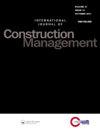缩小建筑信息建模教育与实践之间的差距:基于能力的教育视角
IF 3.4
Q2 CONSTRUCTION & BUILDING TECHNOLOGY
International Journal of Construction Management
Pub Date : 2023-11-18
DOI:10.1080/15623599.2022.2077546
引用次数: 0
摘要
摘要 本研究报告是一项案例研究,旨在调查新西兰(NZ)BIM 高等教育与建筑行业需求之间的差距。具体而言,研究旨在:(1)确定行业对 BIM 能力的要求;(2)考察新西兰 BIM 高等教育的现状;(3)确定并分析当前 BIM 教育与行业需求之间的差距。通过 BIM 招聘广告收集数据,以确定行业对 BIM 能力的要求和 BIM 的主要用途。此外,还从九所高等院校收集了 33 门课程的数据。结果表明,BIM 能力的类型和水平(即认知水平)之间存在差异。结果表明,除 4D 建模外,几乎所有 BIM 用途的教学都存在缺失环节。对于几种 BIM 用途,很大一部分学习成果侧重于 "理解",而《新西兰 BIM 手册》则要求更高水平的应用和评估。为了缩小差距,应按学科确定核心能力集。BIM 能力还可根据 BIM 用途、BIM 流程和阶段以及项目角色进行分类。本文提出了一个概念框架,为未来基于能力的 BIM 教育指明了方向。本文章由计算机程序翻译,如有差异,请以英文原文为准。
Bridging the gap between building information modelling education and practice: a competency-based education perspective
Abstract This study reports a case study that investigates the gap between BIM tertiary education and the building industry’s needs in New Zealand (NZ). In specific, it aims to (1) identify the industry’s requirements on BIM competencies, (2) examine the status quo of BIM tertiary education in NZ, and (3) identify and analyse the gaps between current BIM education and the industry’s needs. Data were collected through BIM job advertisement to identify the industry’s requirements of BIM competencies and top BIM uses. Data of thirty-three courses were also collected from nine tertiary institutions. Results indicated that there were discrepancies between the type and level (i.e. cognitive levels) of BIM competencies. It was indicated that missing links existed in almost all BIM uses that were taught, except 4D modelling. A large proportion of learning outcomes were focused on ‘understanding’ for several BIM uses, while NZ BIM Handbook requires higher levels of application and evaluation. To bridge the gaps, core competence sets should be determined by disciplines. BIM competencies can also be classified based on BIM uses, BIM processes and phases, and project roles. This paper proposed a conceptual framework, which suggests the way ahead towards future competency-based BIM education.
求助全文
通过发布文献求助,成功后即可免费获取论文全文。
去求助
来源期刊

International Journal of Construction Management
MANAGEMENT-
CiteScore
8.60
自引率
17.90%
发文量
112
期刊介绍:
The International Journal of Construction Management publishes quality papers aiming to advance the knowledge of construction management. The Journal is devoted to the publication of original research including, but not limited to the following: Sustainable Construction (Green building; Carbon emission; Waste management; Energy saving) Construction life cycle management Construction informatics (Building information modelling; Information communication technology; Virtual design and construction) Smart construction (Robotics; Artificial intelligence; 3D printing) Big data for construction Legal issues in construction Public policies for construction Building and Infrastructures Health, safety and well-being in construction Risk management in construction Disaster management and resilience Construction procurement Construction management education
 求助内容:
求助内容: 应助结果提醒方式:
应助结果提醒方式:


